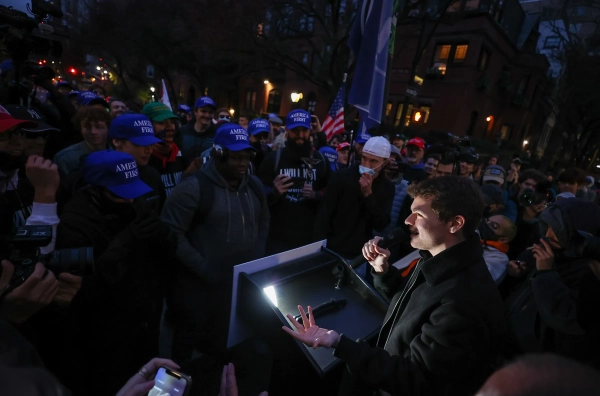
On October 8, two prominent voices in right-leaning media engaged in an almost four-hour dialogue. The presenter was Dave Smith, a Jewish comedian with libertarian leanings who has established himself as a forthright detractor of Israel’s conflict in Gaza. His invitee was Nick Fuentes, a ringleader of the anti-Semitic “Groyper” faction that has seen increasing acceptance among the grassroots of the MAGA movement.
At the start of their discussion, Smith addressed the obvious: Why would he, a Jewish comedian, have someone like Fuentes as a guest on his platform? Smith’s explanation was that their aligned political views, especially concerning Gaza, meant more to him than Fuentes’ animosity.
“I don’t actually consider prejudice to be the most detrimental thing. It can be unfavorable, but it isn’t the worst,” Smith expressed. “As someone who is Jewish…there exist those who harbor hatred for Jews, and perhaps I should maintain composure. Because it’s somewhat challenging for individuals to detest those who treat them with respect.”
In response, Fuentes portrayed himself as an unfairly treated casualty of cancel culture. In Fuentes’ account, influential right-wing commentators such as Ben Shapiro and Jordan Peterson were unjustly targeting him based on particular and inexact extracts.
On the Right
The concepts and patterns propelling the conservative agenda, from senior correspondent Zack Beauchamp.
Email (required)Sign UpBy submitting your email, you agree to our Terms and Privacy Notice. This site is protected by reCAPTCHA and the Google Privacy Policy and Terms of Service apply.
“People are judged by portions of what they say,” Fuentes remarked. “These are instruments of reputational destruction. They disapprove of your stance, so they seek elements that will offend people.”
Around the same period, on his own program, Fuentes presented a concise commentary on the historical roots of anti-Semitism. He suggests a straightforward narrative: Jewish people warrant it.
“As a verb, what does ‘Jew’ mean? It signifies dishonesty, deceit, acting in malice as though it’s ingrained. Where do you presume that comes from?” Fuentes inquired. “Everyone, in every country, at all points in time, over millennia, ultimately concludes that Jews are consistently insincere.”
This was typical for Fuentes: a figure who has lauded Hitler as “amazing” and implied that Jews should either be compelled to leave the United States or embrace Christianity. He was not quoted out of context or unintentionally prejudiced: attributing America’s difficulties to its Jewish population has been his focal point for close to a decade. Acting “cool” on Smith’s behalf would not persuade Fuentes to reconsider his aversion to Jews.
Yet, Smith’s absurd simplicity reveals a more profound issue: an escalating anti-Semitism predicament on the MAGA right that is largely self-imposed, with the potential to elevate figures like Fuentes to unprecedented levels of authority. And the GOP’s leadership is now grappling to manage it.
The disclosure of private Republican group discussions to Politico, featuring messages from a notable Trump administration figure by the name of Paul Ingrassia, brought to light various messages containing outright bigotry and even adulation for Hitler. The presence of these texts isn’t the only significant element, but also the very fact they were revealed — suggesting a member on the right, who participated in these exchanges, sought to remove their internal adversaries.
Indeed, there is legitimate and increasing acknowledgment — within the upper echelons of conservatism — that they face a problem of anti-Semitism.
Chris Rufo, the Trump right’s main advocate on cultural matters, cautioned in March regarding “prominent online commentators” who were spreading “subtle, right-coded conspiracy theory” in which Jews “have seized influence over American media, saturated society with pornography, and orchestrated sex-related blackmail operations to ensure backing for Israel.”
Shapiro provided a comparable analysis in a recent dialogue with the Jerusalem Post. “There exists a faction of the Right that is incredibly prone to conspiracy and views Jews as a conspiring force,” he stated. “You attract significantly more interest if you are advancing an anti-Israel, anti-Jewish perspective rather than its inverse.”
These apprehensions generally focus on influencers and prominent individuals: Fuentes, clearly, but also Tucker Carlson, Candace Owens, Kanye West, Darryl Cooper, Andrew Tate, and Representative Marjorie Taylor Green (R-GA). According to figures like Shapiro and Rufo, the premise is that these individuals are the genesis of the rot demonstrated in those group conversations, a malignancy on the GOP that must be confronted and potentially eradicated from the broader right.
Yet this elicits a more profound and disconcerting question: How have they managed to amass such a sizable following? Why do “you garner significantly more interest” currently if you disseminate right-coded anti-Semitism? And why is it that so many of the party’s youthful operatives are drawn to neo-Nazism?
The explanation, supported by readily accessible research and personal conversations with distinguished right-wing personalities, is alarmingly straightforward: President Donald Trump has effectively transformed the right into the primary sanctuary for conspiratorial extremism.
Although the left encounters its own difficulties with anti-Semitism, particularly in relation to burgeoning anti-Zionist sentiments, the right is capitalizing on a more time-honored and conventional manifestation of Jew-hatred — one that has persisted in American politics for an extended period and, until recently, was perceived as inappropriate for anyone bordering on the mainstream.
But amidst the Trump era, attitudes like Smith’s — the notion that prejudice isn’t “the most detrimental aspect” — have evolved into the norm, constituting a form of anti-anti-racism that solidifies the Trumpist political bloc. This “no enemies to the right” mindset — perhaps most strikingly manifested by Vice President JD Vance’s reluctance to forcefully condemn the infamous Young Republicans group chat — coupled with the technological advancements in streaming video and crowdfunding, paved the way for America’s anti-Semites to exploit in their pursuit of amplified prosperity, clout, and influence.
“It transcends ‘no guardrails’ — it’s policing to ensure there are no barriers,” remarks Richard Hanania, an influential writer on the right (and, notably, a former poster on a white nationalist forum).
As the issue intensifies, and warnings from voices like Rufo and Shapiro become increasingly severe, there exists a genuine prospect that this discord will escalate into an outright civil discord — one that will position significant and influential right-wing factions in opposition to each other, in a manner that numerous past intra-right conflicts have failed to achieve.
The result of that power struggle could substantially influence the trajectory of both the Republican Party and American Jewry.
Part I: The demand for anti-Semitism
In 2022, researchers Eitan Hirsh and Laura Royden released a significant document concerning the allocation of anti-Semitic beliefs across the ideological landscape. Considered influential during its initial publication, the document now exhibits foresight — a preemptive justification for the popularity of advocating anti-Semitism with younger conservative demographic groups in 2025.
The key conclusion arises from a study that probed 3,500 American citizens on whether they endorsed three claims regarding American Jews, utilizing a scale from 1 (strongly disagree) to 5 (strongly agree):
- Jews maintain greater loyalty to Israel than to America.
- It is acceptable for critics of Israeli policies and actions to initiate boycotts against Jewish-owned businesses within their respective communities.
- Jews wield excessive influence in the United States.
The answers revealed two distinct patterns. First, Americans leaning right demonstrated greater propensity to concur with these statements relative to those on the left. Second, younger individuals displayed a heightened inclination to agree compared to older ones.

In a succeeding document, Hersh and Royden explored a noteworthy racial trend within the data. Regardless of political orientation, Black and Latino individuals in America expressed a greater propensity to concur with anti-Semitic assertions compared to their white peers. As of current evaluations, Americans most susceptible to articulating anti-Semitic views are Black or Latino conservatives aged 18 to 30.
In 2022, the aforementioned outcomes presented a conundrum. However, following the outcomes of the 2024 elections, during which Trump successfully recruited considerable numbers of young and Latino voters, a coherent interpretation emerges — one that further elucidates the rise of anti-Semitism among the youthful right.
Substantial proof suggests that Trump performs exceptionally well with individuals expressing limited confidence in social and political systems: negligible confidence in government, professionals, and even fellow citizens. Over a decade spent involved in politics, Trump has molded the GOP into the principal haven for these disenfranchised voters, who previously were more equally distributed across the political spectrum. The gains achieved in 2024 among young and non-white voting blocs were likely derived directly from their most skeptical factions.
Not surprisingly, low confidence exhibits a robust correlation with holding beliefs in conspiracy theories. Fundamentally, anti-Semitism manifests as a 3,000-year-old conspiracy theory postulating that all global adversity can be attributed to the classified and untrustworthy manipulations of a select ensemble (i.e., the Jews).
Historically speaking, anti-Semitic texts constitute the cornerstone of modern thought and argumentation — the idiosyncratic arrangement of disconnected information, the proclamation of the corruption of established narratives — that define ideologies varying from UFOlogy to resistance to vaccines. In his published work Conspiracy Theories, psychologist Jovan Byford illustrates the historical factors contributing to the almost unavoidable gravitation of contemporary conspiracy theorists towards Jews as the ultimate perpetrators:
From the mid-nineteenth century until the culmination of the Second World War, anti-Semitism was the prevalent theme in conspiracy theories. A significant portion of the conspiracy-related content of that era, as well as content pertaining to that period, centers on the premise of a Jewish conspiracy. Consequently, when modern-day authors reflect on the chronology of the conspiracy — a task requiring them to acknowledge the relevance of preceding conspiracies and conspiracy theories — they are inevitably confronted with the anti-Semitic legacy of the conspiracy-based culture.
When synthesizing all of the abovementioned data, one arrives at a comprehensive premise concerning the prevalence of anti-Semitism among young conservatives — predominantly young, non-white conservatives — as the most inclined demographic in America.
Presently, assuming the role of a young conservative entails having deep and profound reservations regarding established authorities and accepted accounts, adhering to the principle that truth constitutes the element “they” wish to conceal. In 2023, conservative author Mary Katharine Ham provided a concise justification when probed on the burgeoning mistrust of institutions among conservatives: “largely because the institutions themselves have warranted it.”
Given that young people are disproportionately prone to consume online content and adhere to influencers, their digital ecosystem becomes a natural habitat for right-wing anti-Semites striving to assemble a wide-ranging audience. Individuals such as Fuentes, Owens, and Carlson are capable of amassing audiences through these platforms by directly connecting with individuals interested in a particularly right-leaning variant of anti-Semitism — one characterized by conspiracy and ethno-nationalism. This concept explains the programmatic title of Fuentes: America First.
“The populist attitude — a compilation of cognitive characteristics — motivates an individual’s inclination to partake in the Trump-era GOP. Such an attitude entails conspiratorial inclinations, as well as ethnonationalism,” Hanania observes. “Historically, conspiratorial ethnonationalist movements have generally exhibited a positive disposition towards Jewish people? Negatively. This development simply represents the natural trajectory of this situation.”
Part II: A milieu of harmful acceptance
The intention is not to absolve the American left of the presence of anti-Semitism. Following October 7, such a notion would be inappropriate. The displays of celebration corresponding to the day’s carnage and the intimidation of Jewish students instigated by members of pro-Palestinian activist collectives exemplify a critically important issue, one that I have discussed previously. Historically, anti-Semitism fueled by conspiracy theories can easily originate from left-leaning elements (consider the case of the Soviet Union).
However, a scenario requires further investigation. It is on the right that self-proclaimed anti-Semites such as Fuentes thrive, where figures as inclined to conspiracy theories as Carlson secure opportunities to speak at the party’s national convention, and where young operatives communicate their deep fondness for Hitler. Despite the notable issues besetting the left, nothing approaches the established framework that subsists for anti-Semitism rooted in the left, as observed in its right-wing counterpart.
Source: vox.com






